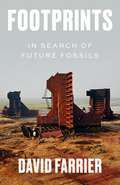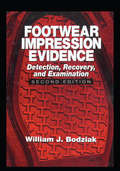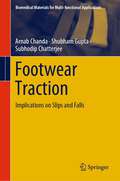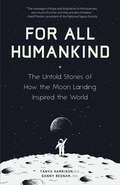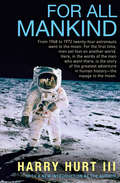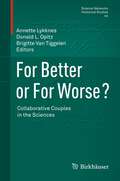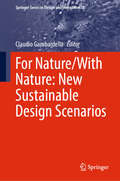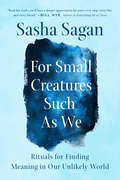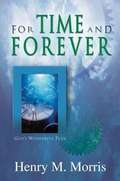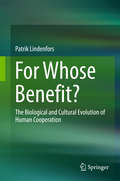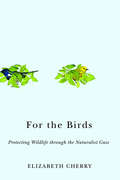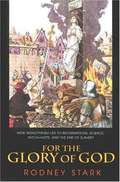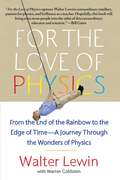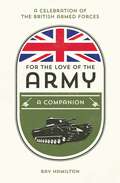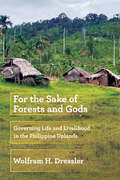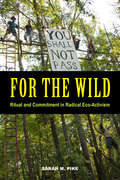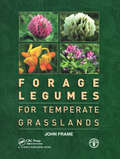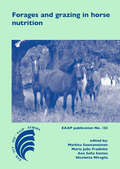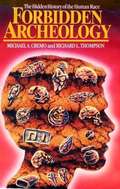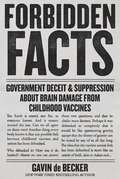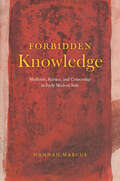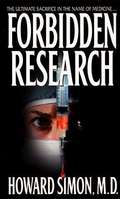- Table View
- List View
Footprints: In Search of Future Fossils
by David FarrierWhat will the world look like in ten thousand years--or ten million? What kinds of stories will it tell about us? In Footprints, David Farrier surveys the traces we will leave for people of the very distant future. Modern civilization has created objects and landscapes with the potential to endure through deep time, including the plastic polluting the oceans, the nuclear waste entombed within the earth, and the thirty million miles of paved roads spanning the planet. Our carbon could linger in the atmosphere for a hundred thousand years, and the remains of our cities will persist millions of years from now as a layer in the rock. These future fossils have the potential to reveal much about how we lived in the twenty-first century. Crossing the boundaries of literature, art, and science, Footprints is a profound meditation on climate change and the Anthropocene, and an urgent search for the fossils--industrial, chemical, geological--that humans are leaving behind. Traveling from the Baltic Sea to the Great Barrier Reef, and from an ice core laboratory in Tasmania to Shanghai, one of the world's biggest cities, Farrier describes a planet that is changing rapidly, with consequences beyond the scope of human understanding. How do we want to be remembered in the myths and stories of our distant descendants? As much a message of hope as a warning, Footprints will change not only how you think about the future but also how you see the world today. DAVID FARRIER teaches at the University of Edinburgh. In 2017, Footprints won the Royal Society of Literature s Giles St. Aubyn Award for first commissioned work of nonfiction. He lives in Edinburgh.
Footwear Impression Evidence: Detection, Recovery and Examination, SECOND EDITION (Practical Aspects of Criminal and Forensic Investigations)
by William J. BodziakReviewed and recognized as the most authoritative source in the field, this book describes the methods used worldwide to recover and identify footwear impressions from the scene of a crime. In this new edition, everything, including the original twelve chapters, bibliography, appendix, etc., has been clarified, updated and expanded. This edition includes updated and new information on recovery procedures and materials such as lifting, photography and casting; chemical enhancement; updated information about footwear manufacturing; footwear sizing; and known impression techniques and materials. WHAT’S NEW IN THE SECOND EDITION: Besides updating and expanding the twelve original chapters, Footwear Impression Evidence: Detection, Recovery and Examination, Second Edition adds three new chapters: one chapter on barefoot evidence, which concerns impressions made by the naked or sock-clad foot or those which remain in abandoned or discarded footwear; another new chapter on several cases in which the footwear impression evidence was of primary importance in bringing about a conviction or confession; and finally, a new chapter on the footwear impression evidence in the O.J. Simpson criminal and civil cases.
Footwear Traction: Implications on Slips and Falls (Biomedical Materials for Multi-functional Applications)
by Arnab Chanda Shubham Gupta Subhodip ChatterjeeThis book discusses the science of footwear traction and its relationship with slips and falls. It presents a detailed introduction to slips and falls and how crucial footwear traction is to avoid such incidents. The book covers ergonomics involved in the development of tread designs and the study of their effect on traction across footwear and systematically modified shoes. It discusses characterization techniques employed in the study of footwear traction across normal gait activities, such as walking and running and in sports, such as sprinting, basketball, and football. The book also covers the role of flooring and slippery contaminants on footwear traction and its generalizability. Additionally, the book also presents how the wear of footwear outsoles may reduce the traction at the shoe-floor and lead to slips and falls. It also discusses the challenges with the existing footwear traction testing methods, and the latest developments in this niche area are highlighted. The book is a valuable reference for researchers and professionals interested in ergonomics, footwear technology, manufacturing engineering, safety engineering, and design engineering and its allied fields.
For All Humankind: The Untold Stories of How the Moon Landing Inspired the World
by Tanya Harrison Danny BednarStories of the first moon landing as experienced by real people from around the world—great for fans of A Man on the Moon, Rocket Men, or First Man. Astronauts Neil Armstrong and Edwin &“Buzz&” Aldrin left humanity&’s first footprints on the Moon, July 20, 1969. The plaque they left behind reads, &“Here men from the planet Earth first set foot upon the Moon, July 1969, A.D. We came in peace for all mankind.&” But was the Apollo 11 moon landing mission really a global endeavor? How did people outside the United States view these &“rocket men?&” Against the political backdrop of the Cold War between the United States and the Soviet Union, was it, indeed, &“For all mankind?&” Dr. Tanya Harrison and Dr. Danny Bednar have talked to individuals from a variety of locations outside the United States, to see how this event touched the lives of people across the world. Enthusiasts of space travel, the Apollo missions, and the moon landings will love this book. These previously untold stories reveal the impact of the moon landings around the globe, and what having a &“man on the moon&” meant to the international community. In this exciting book, readers will:· Find interviews with eight non-Americans to get their perspectives· Be inspired by their memories of the event· Learn more about one of the most historic events in human history&“An absolute delight! By telling the story of the 1969 Apollo 11 moon landing through the eyes of observers from around the world, [Harrison and Bednar] bring freshness to it that is utterly beguiling.&”—Dr. Andrew Maynard, author of Films from the Future and Future Rising
For All Mankind
by Harry Hurt III&“Far more than a history of lunar exploration . . . [Hurt] is at his best in the deft sketches of the astronauts—as they were and as they became.&”—Chicago Tribune Between December 1968 and December 1972, twenty-four men captured the imagination of the world as they voyaged to the moon. In For All Mankind, Harry Hurt III presents a dramatic, engrossing, and expansive account of those journeys. Based on extensive research and exclusive interviews with the Apollo astronauts, For All Mankind remains one of the most comprehensive and revealing firsthand accounts of space travel ever assembled. In their own words, the astronauts share the sights, sounds, thoughts, fears, hopes, and dreams they experienced during their incredible voyages. In a compelling narrative structured as one trip to the moon, Harry Hurt recounts all the drama and danger of the lunar voyages, from the anxiety of the astronauts&’ prelaunch procedures through the euphoria of touchdown on the lunar surface. Updated with a new introduction by the author for the 50th anniversary of the Apollo 11 moon landing, For All Mankind is both an extraordinary adventure story and an important historical document. &“Hurt&’s timely book is like an instant replay of the dramatic moon flight years . . . Hurt tells us of the hardships and the successes of the Apollo program, the remarkable journey to the moon, of the astronauts and technicians who made it possible and the goals of the nation in space.&”—Houston Chronicle &“The meat here lies in the lunar voyage itself, an irresistible mix of danger, courage, tedium, and spectacle, evoked with unprecedented detail by those who went there.&”—Kirkus Reviews
For Better or For Worse? Collaborative Couples in the Sciences
by Annette Lykknes Donald L. Opitz Brigitte Van TiggelenIn this volume, a distinguished set of international scholars examine the nature of collaboration between life partners in the sciences, with particular attention to the ways in which personal and professional dynamics can foster or inhibit scientific practice. Breaking from traditional gender analyses which focus on divisions of labor and the assignment of credit, the studies scrutinize collaboration as a variable process between partners living in the nineteenth and twentieth centuries who were married and divorced, heterosexual and homosexual, aristocratic and working-class and politically right and left. The contributors analyze cases shaped by their particular geographical locations, ranging from retreat settings like the English countryside and Woods Hole, Massachusetts, to university laboratories and urban centers in Berlin, Stockholm, Geneva and London. The volume demonstrates how the terms and meanings of collaboration, variably shaped by disciplinary imperatives, cultural mores, and the agency of the collaborators themselves, illuminate critical intellectual and institutional developments in the modern sciences.
For Good Measure: The Ways We Say How Much, How Far, How Heavy, How Big, How Old
by Ken RobbinsThe book presents some facts about units of measure, and how they compare to one another. The author has included the widely used metric equivalents of most measures that are mentioned.
For Nature/With Nature: New Sustainable Design Scenarios (Springer Series in Design and Innovation #38)
by Claudio GambardellaThis volume contributes to the construction of a multi-voice mosaic on the theme of Nature and the relationship between Man (understood as designer) and Nature by emphasizing the innovative and sustainable proposals coming from the discipline of design, in its many facets and interdisciplinary contributions. Since it isn’t discussed the creative and economic effort that designers, institutions and companies have been leading for years to improve human living conditions, preference will be given to scientific contributions (unpublished or not yet fully known case studies, projects of strategies, products, systems and services, theoretical contributions, communication) that are an expression of a new approach to Nature, seen as our ally and object of an ethics of care. The focus is the design both in its role as innovation driver and interpreter of social evolution, that must be considered within the human-nature relationship. The topics identify some of the most relevant fields of development in which "Design Driven Innovation" can be developed in the respect of perspective of a new relationship with nature.
For Small Creatures Such as We: Rituals for Finding Meaning in Our Unlikely World
by Sasha Sagan"What is the meaning of life? Sagan finds its meaning everywhere--with her family, around the world, and especially among the stars of the cosmos. Read her work; you'll have a deeper appreciation for your every step, every bite, and every breath." --Bill NyePart memoir, part guidebook, and part social history, For Small Creatures Such as We is the first book from the daughter of Carl Sagan and Ann Druyan--a luminous exploration of Earth's marvels that require no faith in order to be believed.Sasha Sagan was raised by secular parents, the astronomer Carl Sagan and the writer and producer Ann Druyan. They taught her that the natural world and vast cosmos are full of profound beauty, that science reveals truths more wondrous than any myth or fable. When Sagan herself became a mother, she began her own hunt for the natural phenomena behind our most treasured occasions--from births to deaths, holidays to weddings, anniversaries, and more--growing these roots into a new set of rituals for her young daughter that honor the joy and significance of each experience without relying on religious framework.As Sagan shares these rituals, For Small Creatures Such as We becomes a moving tribute to a father, a newborn daughter, a marriage, and the natural world--a celebration of life itself, and the power of our families and beliefs to bring us together.
For Time and Forever
by Dr Henry M. MorrisIs all life a result of random processes? We plan our lives and daily routines, but is there a "plan"? Does someone manage individual lives and the order of the universe? The answer for people of faith, of course, is that God controls all things. The logical conclusion of that belief is that He also has a plan for each individual, and a plan for Earth itself. Man was created to have dominion over the planet, to care for it and its creatures. In For Time and Forever, Bible authority Henry Morris explores the breadth of what it means to have purpose in God's creation. Besides debunking evolutionary myths, Dr. Morris also answers the cry of man: where do I fit? Does God have a purpose for me? Morris recognizes that since our time is short in terms of life span, we must all work to fulfill the Great Commission: we must recognize the biblical truth that there is an overall plan of salvation and we must work to implement it. Answering age-old questions like "Why do bad things happen?" and "Is there a heaven and a hell?" Morris provides a framework for laymen and scholars alike to see their true purposes.
For Whose Benefit?
by Patrik LindenforsThis book takes the reader on a journey, navigating the enigmatic aspects of cooperation; a journey that starts inside the body and continues via our thoughts to the human super-organism. Cooperation is one of life's fundamental principles. We are all made of parts - genes, cells, organs, neurons, but also of ideas, or 'memes'. Our societies too are made of parts - us humans. Is all this cooperation fundamentally the same process? From the smallest component parts of our bodies and minds to our complicated societies, everywhere cooperation is the organizing principle. Often this cooperation has emerged because the constituting parts have benefited from the interactions, but not seldom the cooperating units appear to lose on the interaction. How then to explain cooperation? How can we understand our intricate societies where we regularly provide small and large favors for people we are unrelated to, know, or even never expect to meet again? Where does the idea come from that it is right to risk one's life for country, religion or freedom? The answers seem to reside in the two processes that have shaped humanity: biological and cultural evolution.
For the Birds: Protecting Wildlife through the Naturalist Gaze (Nature, Society, and Culture)
by Elizabeth CherryOne in five people in the United States is a birdwatcher, yet the popular understanding of birders reduces them to comical stereotypes, obsessives who only have eyes for their favorite rare species. In real life, however, birders are paying equally close attention to the world around them, observing the devastating effects of climate change and mass extinction, while discovering small pockets of biodiversity in unexpected places. For the Birds offers readers a glimpse behind the binoculars and reveals birders to be important allies in the larger environmental conservation movement. With a wealth of data from in-depth interviews and over three years of observing birders in the field, environmental sociologist Elizabeth Cherry argues that birders learn to watch wildlife in ways that make an invaluable contribution to contemporary conservation efforts. She investigates how birders develop a “naturalist gaze” that enables them to understand the shared ecosystem that intertwines humans and wild animals, an appreciation that motivates them to participate in citizen science projects and wildlife conservation.
For the Glory of God: How Monotheism Led to Reformations, Science, Witch-Hunts, and the End of Slavery
by Rodney StarkRodney Stark's provocative new book argues that, whether we like it or not, people acting for the glory of God have formed our modern culture. Continuing his project of identifying the widespread consequences of monotheism, Stark shows that the Christian conception of God resulted--almost inevitably and for the same reasons--in the Protestant Reformation, the rise of modern science, the European witch-hunts, and the Western abolition of slavery. In the process, he explains why Christian and Islamic images of God yielded such different cultural results, leading Christians but not Muslims to foster science, burn "witches," and denounce slavery. With his usual clarity and skepticism toward the received wisdom, Stark finds the origins of these disparate phenomena within monotheistic religious organizations. Endemic in such organizations are pressures to maintain religious intensity, which lead to intense conflicts and schisms that have far-reaching social results. Along the way, Stark debunks many commonly accepted ideas. He interprets the sixteenth-century flowering of science not as a sudden revolution that burst religious barriers, but as the normal, gradual, and direct outgrowth of medieval theology. He also shows that the very ideas about God that sustained the rise of science led also to intense witch-hunting by otherwise clear-headed Europeans, including some celebrated scientists. This conception of God likewise yielded the Christian denunciation of slavery as an abomination--and some of the fiercest witch-hunters were devoted participants in successful abolitionist movements on both sides of the Atlantic. For the Glory of God is an engrossing narrative that accounts for the very different histories of the Christian and Muslim worlds. It fundamentally changes our understanding of religion's role in history and the forces behind much of what we point to as secular progress.
For the Love of Physics: From the End of the Rainbow to the Edge Of Time - A Journey Through the Wonders of Physics
by Walter Lewin“YOU HAVE CHANGED MY LIFE” is a common refrain in the emails Walter Lewin receives daily from fans who have been enthralled by his world-famous video lectures about the wonders of physics. “I walk with a new spring in my step and I look at life through physics-colored eyes,” wrote one such fan. When Lewin’s lectures were made available online, he became an instant YouTube celebrity, and The New York Times declared, “Walter Lewin delivers his lectures with the panache of Julia Child bringing French cooking to amateurs and the zany theatricality of YouTube’s greatest hits.” For more than thirty years as a beloved professor at the Massachusetts Institute of Technology, Lewin honed his singular craft of making physics not only accessible but truly fun, whether putting his head in the path of a wrecking ball, supercharging himself with three hundred thousand volts of electricity, or demonstrating why the sky is blue and why clouds are white. Now, as Carl Sagan did for astronomy and Brian Green did for cosmology, Lewin takes readers on a marvelous journey in For the Love of Physics, opening our eyes as never before to the amazing beauty and power with which physics can reveal the hidden workings of the world all around us. “I introduce people to their own world,” writes Lewin, “the world they live in and are familiar with but don’t approach like a physicist—yet.” Could it be true that we are shorter standing up than lying down? Why can we snorkel no deeper than about one foot below the surface? Why are the colors of a rainbow always in the same order, and would it be possible to put our hand out and touch one? Whether introducing why the air smells so fresh after a lightning storm, why we briefly lose (and gain) weight when we ride in an elevator, or what the big bang would have sounded like had anyone existed to hear it, Lewin never ceases to surprise and delight with the extraordinary ability of physics to answer even the most elusive questions. Recounting his own exciting discoveries as a pioneer in the field of X-ray astronomy—arriving at MIT right at the start of an astonishing revolution in astronomy—he also brings to life the power of physics to reach into the vastness of space and unveil exotic uncharted territories, from the marvels of a supernova explosion in the Large Magellanic Cloud to the unseeable depths of black holes. “For me,” Lewin writes, “physics is a way of seeing—the spectacular and the mundane, the immense and the minute—as a beautiful, thrillingly interwoven whole.” His wonderfully inventive and vivid ways of introducing us to the revelations of physics impart to us a new appreciation of the remarkable beauty and intricate harmonies of the forces that govern our lives.
For the Love of the Army: A Celebration of the British Armed Forces
by Ray HamiltonFrom the heroes, regiments and famous battles of the British Army’s impressive history to the service people of today, this book celebrates the achievements and ongoing importance of the UK’s land force. It also explores the skills, weaponry and equipment necessary to keep the Army battle-ready and able to face any challenge.
For the Love of the Army: A Celebration of the British Armed Forces
by Ray HamiltonFrom the heroes, regiments and famous battles of the British Army’s impressive history to the service people of today, this book celebrates the achievements and ongoing importance of the UK’s land force. It also explores the skills, weaponry and equipment necessary to keep the Army battle-ready and able to face any challenge.
For the Sake of Forests and Gods: Governing Life and Livelihood in the Philippine Uplands
by Wolfram H. DresslerFor the Sake of Forests and Gods documents the consequences of nonstate actors impinging on the existence of Indigenous peoples in the remote highlands of Palawan Island, the Philippines. Nimble, focused, and well-funded, religious and environmental organizations increasingly assume governmental authority over the lives and livelihoods of the Pala'wan people within their ancestral territories.Wolfram H. Dressler traces these actors' history and contemporary practices, revealing how they bypass the state to govern the less governed. In the highlands, environmental NGOs valorize customary objects and practices to suppress swidden and support forest conservation, while evangelical missionaries regulate Pala'wan beliefs, health, and hygiene.Bridging material studies and biopolitics, For the Sake of Forests and Gods explores how these nonstate actors use customary objects for comprehensive reforms of Pala'wan bodies and souls, centering on how the unique properties of the Tingkep basket mediate nonstate biopower. These reforms impact highlanders differently: some adopt biopolitical ideals willingly, others for political and economic gain. Yet others resist interventions, prioritizing family livelihoods. Ultimately, Dressler argues that Indigenous sovereignty matters more than ever as nonstate biopower intensifies in Southeast Asia's uplands.
For the Wild: Ritual and Commitment in Radical Eco-Activism
by Sarah M. PikeFor the Wild explores the ways in which the commitments of radical environmental and animal-rights activists develop through powerful experiences with the more-than-human world during childhood and young adulthood. The book addresses the question of how and why activists come to value nonhuman animals and the natural world as worthy of protection. Emotions and memories of wonder, love, compassion, anger, and grief shape activists’ protest practices and help us understand their deep-rooted dedicaztion to the planet and its creatures. Drawing on analyses of activist art, music, and writings, as well as interviews and participant-observation in activist communities, Sarah M. Pike delves into the sacred duties of these often misunderstood and marginalized groups with openness and sensitivity.
Forage Legumes for Temperate Grasslands
by John FrameWith the underpinning role of forage legumes in the nitrogen economy and animal productivity from temperate grasslands certain to expand in the future, particularly in regions where their potential has not yet been realized, it is essential that the wealth of information currently available is widely disseminated. This book serves the purpose with
Forages and grazing in horse nutrition
by Nicoletta Miraglia Maria João Fradinho Ana Sofia Santos Markku SaastamoinenForages should be the basis of all diets in horse feeding. Therefore it is of major importance to determine which parameters will influence their quality. Changes on chemical composition along the vegetative cycle, nutrient losses during harvesting, preservation and storage are factors that could have an effect on nutritive value, as well on digestibility and palatability. A specific grazing and ingesting behaviour, linked to plant preferences and the selection of feeding sites will have an impact on biodiversity. This will determine the options on plant species and varieties and further management of pastures for horses. This book highlights the role of forages and grazing in horse nutrition and also gathers information about related topics, such as the contribution of local breeds for the sustainability and development of rural areas, their impact on landscape and relationships with environmental preservation. This book is the 6th volume in a scientific series conceived through the European Workshop on Equine Nutrition (EWEN) which falls under the umbrella of the Horse Commission of the European Federation of Animal Science (EAAP). All these materials provide an interesting basis for further discussion, not only in specialized forums, but also for those involved in horse production.
Foraminifera and their Applications
by Robert Wynn JonesIn a one-stop resource, this book provides a state-of-the-art overview of all aspects of pure and applied forams studies. Building from introductory chapters on the history of foraminiferal research, and research methods, the book then takes the reader through biology, ecology, palaeoecology, biostratigraphy and sequence stratigraphy. This is followed by key chapters detailing practical applications of forams in petroleum geology, mineral geology, engineering geology, environmental science and archaeology. All applications are fully supported by numerous case studies selected from around the world, providing a wealth of real-world data. The book also combines lavish illustrations, including over 70 stunning original picture-diagrams of foraminifera, with comprehensive references for further reading, and online data tables providing additional information on hundreds of foram families and species. Accessible and practical, this is a vital resource for graduate students, academic micropalaeontologists and professionals across all disciplines and industry settings which make use of foram studies.
Forbidden Archeology
by Michael A. Cremo Richard L. ThompsonThe hidden history of the human race, a remarkably complete review of the scientific evidence concerning human origins.
Forbidden Facts: Government Deceit & Suppression About Brain Damage from Childhood Vaccines
by Gavin de BeckerHave Government agencies and big corporations ever created and promoted outright lies and cover-ups?Of course they have. When they do it together, that is the definition of conspiracy.Internationally recognized criminologist and bestselling author of The Gift of Fear, Gavin de Becker, investigates how the Government &‘debunks&’ inconvenient and unwanted truths. This story of true crime includes bogus research, bribes, compromised experts, paid conspirators, destruction of evidence, and massive publicity campaigns to discredit people and truths that don&’t fit official wishes.Readers are provided real-time access to original source material that clearly details how Government agencies and Big Pharma have routinely conspired to deceive the public on matters of profound importance.
Forbidden Knowledge: Medicine, Science, and Censorship in Early Modern Italy
by Hannah MarcusForbidden Knowledge explores the censorship of medical books from their proliferation in print through the prohibitions placed on them during the Counter-Reformation. How and why did books banned in Italy in the sixteenth century end up back on library shelves in the seventeenth? Historian Hannah Marcus uncovers how early modern physicians evaluated the utility of banned books and facilitated their continued circulation in conversation with Catholic authorities. Through extensive archival research, Marcus highlights how talk of scientific utility, once thought to have begun during the Scientific Revolution, in fact began earlier, emerging from ecclesiastical censorship and the desire to continue to use banned medical books. What’s more, this censorship in medicine, which preceded the Copernican debate in astronomy by sixty years, has had a lasting impact on how we talk about new and controversial developments in scientific knowledge. Beautiful illustrations accompany this masterful, timely book about the interplay between efforts at intellectual control and the utility of knowledge.
Forbidden Research
by Howard Simonmedical thriller in which animal rights activist-terrorists will stop at nothing to put an end to animal-based scientific research
